Broken Sword 5: Building adventure from community, craftsmanship, and goats
Rewind a few months to late August. It’s Gamescom. The second full day of the show, to be precise. The previous day spent covering the opening press conferences, beginning at stupid o’ clock in the morning in a different country entirely, has rather taken its toll. As has the first evening of reconnecting with PR contacts in a most sober and professional fashion. In short, I’m desperately in need of a bit of down time.
The searing lights and pounding bass of the show floor are playing merry Hell with my besieged brain, and the constant assault of shiny, next-gen particle effects, explosions, and shiny, next-gen particle effects bursting out of explosions is having a rather discombobulating effect. But then I step into the small, unassuming booth housing Broken Sword 5: The Serpent's Curse. And ye gods, does it turn out to be exactly what I need.
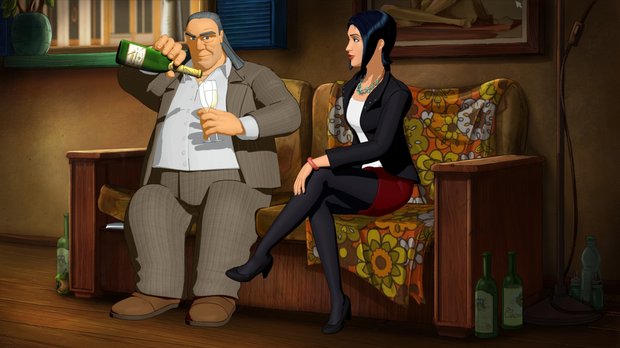
A promising start
After a minute or so’s quiet, coffee-nursing contemplation, I’m joined by Charles Cecil, head of Revolution Software and Broken Sword 5’s lead designer. Bounding into the room with a giddy, slightly side-tracked enthusiasm, full of apologies for his (marginal) late-running amid offers of yet more coffee, he’s the binary opposite of the over-slick, over-rehearsed, PR-spouting producers one so often runs into at these things.
He’s also, with his beaming, utterly informal demeanor, the binary opposite of what you’d expect from a man attempting to relaunch a 17-year-old point-and-click adventure game series after a seven year break, without a publisher, at a big, shiny, 2013 game show full of particle effects and explosions. Over the course of our meeting, "Brilliant!" is to become his unofficial catchphrase. He shows no hint of stress, exhibits a bounty of energetic excitement, and has nothing but the happiest things to say about his game and the process that’s brought it about.
Because that rather unique process seems to be the crux of success for the Broken Sword relaunch. Now free of the trappings of an ‘old’ games industry reliant on publishers and boxed product overheads, Revolution are free--by way of an incredibly successful Kickstarter bid and the joys of digital distribution--to do things entirely their own way. And it seems that arrangement suits Cecil in ways that stretch way beyond the simple matter of business freedom.
“I wrote my first game for the ZX81”, he explains, as we discuss the creative and community-driven advantages of going it alone. “And in those days you sat at desks, and you talked to people and you hoped that they liked it. And it was really fun. And then we got removed as publishers and retailers came along.
“Not to criticise them. That’s just the way of the world. But it got to the extent that retailers, their job was to deal with the public, and publishers primarily were dealing with retailers. That’s why they didn’t like public shows, because it wasn’t their job. It was the retailers’ job to do it. And as developers we found that really frustrating. When people bought games and didn’t have good feedback, they’d write to us. And we’d get furious, because these are the guys that you need to support. These are your fans”
Sign up to the GamesRadar+ Newsletter
Weekly digests, tales from the communities you love, and more
A new beginning
Indeed, looking back at things with the 20-20 hindsight of merry, modern Steam-users enjoying the first wave of an indie gaming renaissance, it’s easy to see the broken logic of a system that so staunchly separated consumers from the creators of the product they were buying. Particularly given that said product wasn’t merely a functional item, like a can opener or a carburetor, but a very human, very crafted, narrative entertainment product touching a great many lives on a very personal level. Surely everyone in that chain of supply, from developer, to publisher, to retailer, to player, benefits from a close relationship between its two extreme ends?
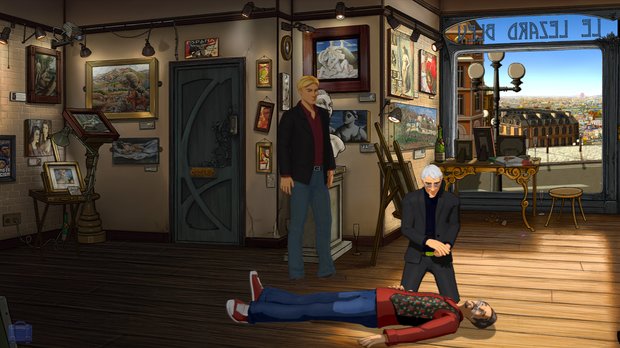
“Well, everyone except some publishers”, Cecil continues. “We worked with Virgin, who were brilliant. But some publishers hate the idea of developers getting close to their audience, because then they have the ability to bypass the publisher. But I’m not out to bash publishers at all. We’ve worked with publishers and we continue to do so. But the big thing [with Broken Sword 5] is that we’ve funded this ourselves, so we’re the ones in the driving seat. And that’s what’s so exciting”
And with Revolution in the driving street, the developer can now travel a very direct route to the fans whose near two-decade enthusiasm for Broken Sword is the sole reason that we even have a new game to talk about. As we discuss Broken Sword old and new, it becomes clear that the immense, worldwide goodwill towards the series is something that crept up on Cecil, initially taking him slightly by surprise--perhaps as a result of that old developer/player disconnect he now decries--but now a fundamental part of how Revolution makes its games. Because Revolution is now very aware that its games are in fact the players’ games.
“Do you remember the goat puzzle?”, Charles asks me, referring to the legendarily obtuse conundrum in the first Broken Sword, which charged hero George Stobbart with escaping the horns of an angry goat by way of abstract use of farming machinery.
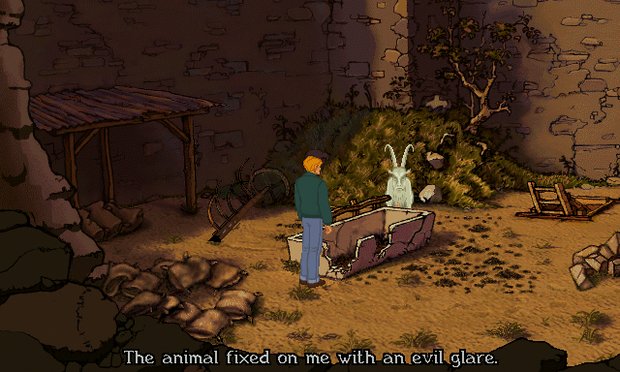
“That one is quite infamous. But I didn’t realise how much feeling there was until I started talking to our community. I had no idea at all, apart from the fact that some time back I was in a taxi, and the driver turned round and asked ‘So what do you do, Guv?’ And I said ‘I write video games. Probably nothing you’ve heard of’. He said ‘Go on, try me’. So I said ‘I wrote a game called Broken Sword’, and he said ‘So you’re the bastard who wrote the goat puzzle, are you!?’ And I wasn’t sure whether I was meant to be flattered or not”
Community service
And via fandom, the influence of that notorious 1996 puzzle stretches even further. As we discuss the surge of interest in Broken Sword 5 that, at Gamescom, led a host of journalists to rearrange schedules in order to see it (Cecil’s appearance at the show was announced decidedly late in the day), he explains how a charming historically-minded adventure game now has a fanbase as hardcore and dedicated as that of any franchise you could mention.
“Well it’s extraordinarily flattering. I mean it really is flattering. And what’s also lovely is, talking about the goat, the fans came up with The Order of the Goat [a Broken Sword 5 pledge club, joined by adding an extra $7.77 to Kickstarter donations]. And it’s like, ‘Guys!’ This girl, she created loads of moulded goats and started selling them on our behalf! And then a week ago a whole lot of Order of the Goat people decided that they were going to come to York! [Revolution’s home town] On a pilgrimage! Some guy flew over from Sweden, met up with a girl from Essex who he’d never met before, but they’re both Order of the Goat people, and then a bunch of them just came up to York. And it’s just brilliant! It’s brilliant!”
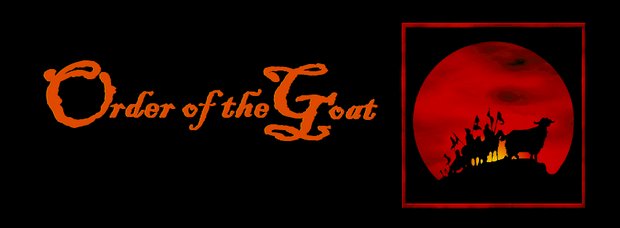
But doesn’t such a close relationship with a dedicated fanbase pose rather a double-edge sword? After all, when you invite your players to have such an open, equal-footed relationship--Cecil will happily be a Facebook friend of any fan, and is “delighted” to reply to messages--surely you risk opening the floodgates to the dread curse of internet entitlement? Particularly with a Kickstarter-funded game, on which you effectively open up Producer credits to the whole world for a nominal fee.
Apparently not in Broken Sword 5’s case. It seems there’s an unusual amount of mutual trust going on here. The series just seems to attract a more benevolent sort of fan, for some reason:
“So we also have 15,000 fans who backed it, who are just brilliant. I announced that the date had to move because we had a significant redesign--we agreed to put in new sections and new characters, and in truth what that allowed me to do was to strip out all the weak bits and add considerably more stronger bits. And that would have been a good few months. So rather nervously, in one of our updates I said to our community, ‘I’m really sorry but it’s going to be a few months later’. Half said ‘Well we didn’t really believe the date anyway’, and the other half said ‘Well take as much time as you need’. And do you know, people have been absolutely brilliant. We have tried to keep in touch. That was the key thing.
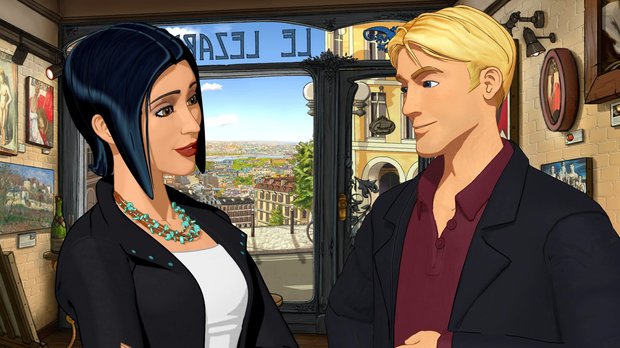
“It’s a real pleasure to be able to work directly with our fanbase. They’ve given us a lot of feedback on what they like and what they don’t like, and in many cases it’s been very valuable and gone straight into the game. I’m terrified for the moment if they turn, but I think we’re close enough to finishing the game now that we’re not going to disappoint. And I’m really proud of the game. I don’t think anyone’s going to think that we haven’t delivered.”
A hand-made tale
So why the distinct lack of gnashed teeth and frustrated demands? Perhaps there’s just something about Broken Sword that attracts a more sedate, thoughtful type of fan. This is, after all, a resolutely narrative, character-focused series driven by whimsical personalities, deep mythology and a profound love of historical fiction. Not to mention a delightful, hand-crafted feel. For all the complex Templar conspiracies found in the early series, this is no over-glossy, high-fallutin’, Assassins’ Creed-style Hollywood epic. The Broken Sword games, particularly the more traditional 2D ones, have always had a much more intimate, human vibe than that.
Charles shows me a scene from the new game. The combination of movie-quality painted backgrounds and cel-shaded character models is a beautiful sight to be hold. Being a SNES stalwart, I’m particularly taken by the insane amount of parallax going on.
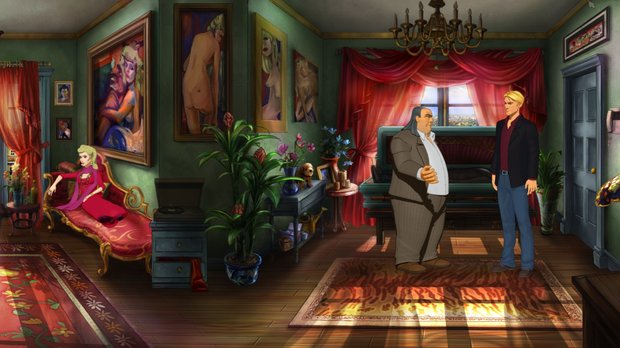
“Actually, we’ve got 6 layers there”, Cecil clarifies. “And thank you for noticing. Do you know what? I live by Yorkminster, and every time I walk past I’m amazed--because everything is in very specific layers, you’ve got the roof in the distance, and you’ve got three layers--you walk past and everything just looks like a cartoon. It’s brilliant.
“We have what I would consider to be really talented layout artists from the cartoon industry. And the interesting thing is that they’re used to drawing things very quickly, because in a cartoon of course, you’re looking mainly at the characters. Whereas in a video game, an adventure game, actually you’re examining the background, so you need to put a lot more work into them. Do you know The Illusionist? One of the girls who was one of the lead designers on that is working in-house to do this stuff”
The personal vibe of Revolution’s design process continues as Cecil takes me through one of the character-based puzzles, in which George must negotiate a particularly spiky Parisian waiter. Given that a late-arriving French journalist has just walked in, he’s eager to explain the character so that his depiction of such an archetype doesn’t cause offense.
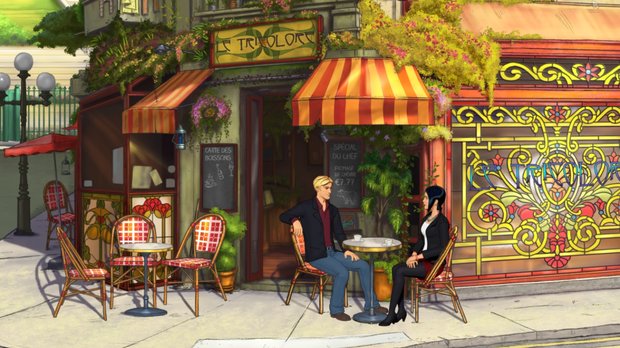
“What we say is that [our characters are] archetypal, not stereotypical. There’s a very important difference. So, how much more archetypal can you get than a mix between Jean-Paul Sartre on one hand and Serge Gainsbourg on the other? So this is our ‘70s view of every Frenchman. They’re intellectual, they’re incredibly sexy, and they’ll put you down at any opportunity.
“Remember, I first went to France in 19… probably 69, and France was very different then. So this is my vision of France, where there were pisoir, everybody smoked Gauloises and Gitanes, and they wore different perfume, and they walked differently and they dressed differently. That’s when I really loved Paris. It was so exciting. I was about seven, and I said to my mother, “Where’s the toilet?”, and she said “Go and ask the policeman”. I said “What do I say?” “Ou est la toilette?” And it took me 10 minutes to build up the confidence. So I have a great affection for France, and Paris in particular.”
Historically successful
By this stage it’s clear that the development of Broken Sword 5 has been a warm, collaborative, utterly people-driven project, literally and figuratively kickstarted by the fans, fuelled by their vision of the series just as much as Revolution's, and, on the development side, entirely underpinned by the personal talents, interests and experiences of its designers. From this point on, the interview--as these sort of interviews often do--freewheels down a long path filled with interesting tangents.
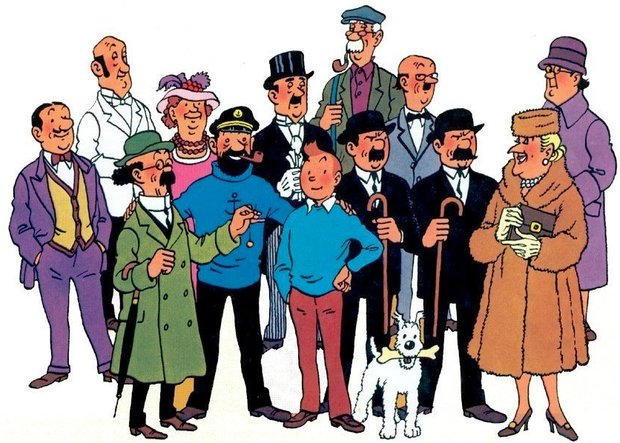
We discuss the comparative narrative merits of Monk and Herge’s Tintin in relation to Revolution’s desire to create a persistent Broken Sword world populated by ongoing character relationships. We go over the apparent discovery--and subsequent loss--in 1944 of the gospels of Mary Magdalene, Judas Escariot and Doubting Thomas, and the bloody, middle-ages feud between the Christian Gnostics and Orthodox.
We discuss the Gnostic interpretation of Lucifer as the God of Knowledge, and Cecil’s red-wine fuelled chat on the subject with the Dean of Yorkminster (“I have to say that she was great. Though she’s always avoided me since then, I’m not quite sure why…”) We go over Cecil’s early morning infiltrations of non-public historical sites on research holidays in France. We cover a great deal of ground, all of it fascinating, all of it very personal, and all of it, in some way, fuelling what Broken Sword 5 is all about.
I step out of the appointment feeling rested, reinvigorated, and ready for the rest of the day. And more to the point, thoroughly excited about a game I already had high hopes for.
Charles Cecil. Bloody nice chap, making a bloody nice game in a bloody nice way.
The first half of Broken Sword 5: The Serpent’s Curse is out now, with part two due in January 2014. It’s available on Steam, Mac, Linux and PlayStation Vita, with iOS and Android ports to follow.



